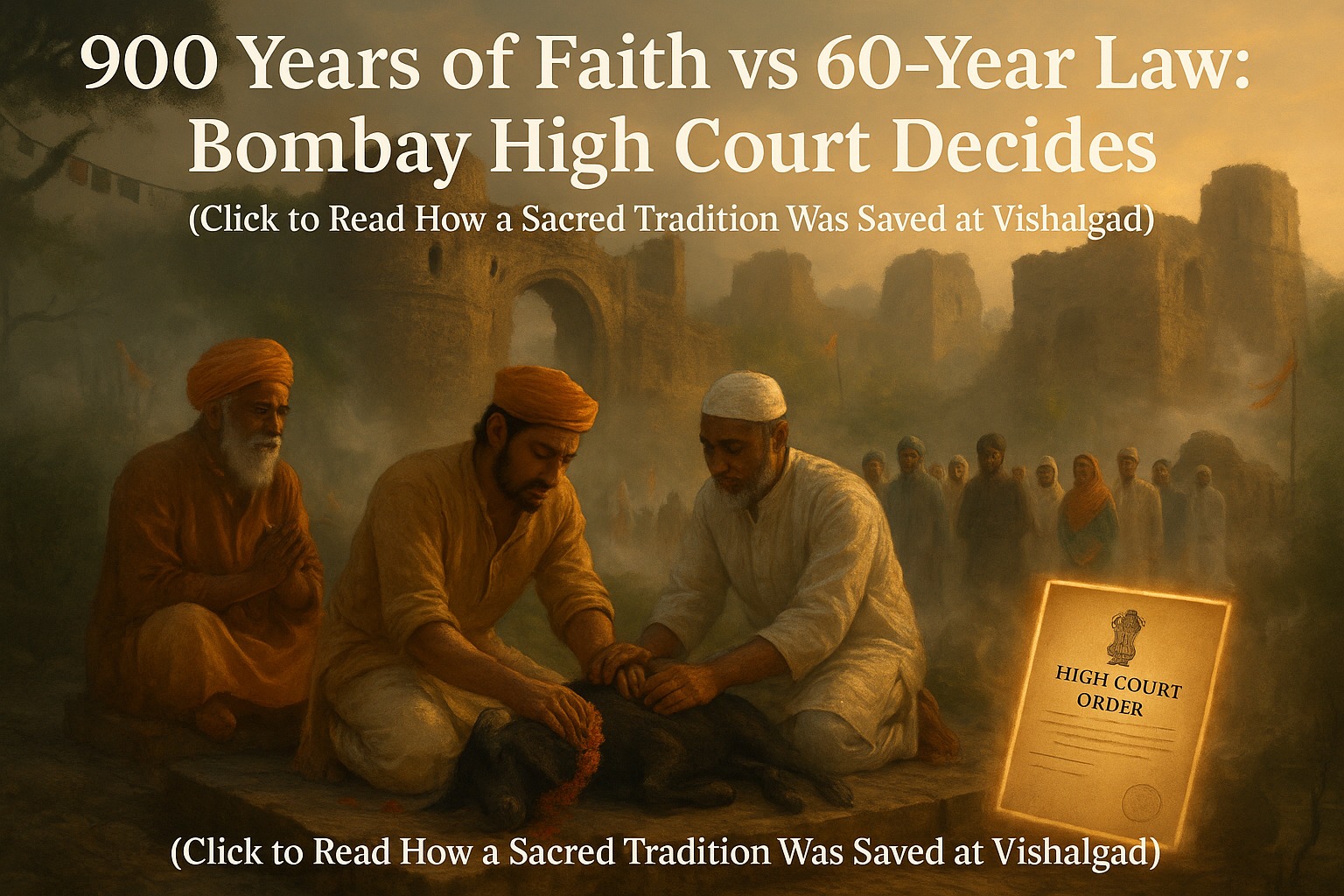BOMBAY HIGH COURT UPHOLDS AGE OLD ANIMAL SACRIFICE TRADITION AT VISHALGAD DARGAH FOR BAKRI EID AND URS
Another landmark decision by The Bombay High Court, that touches on the sensitive intersection of religious tradition, heritage conservation and the very own modern laws or the customary laws. The decision has allowed animal sacrifices to take place during the Bakri Eid and Urs festivals at the Hazrat Peer Malik Rehan Mira Saheb Dargah, in Maharashtra’s Kolhapur district.
The decision, issued by a division bench of Justices B.P. Colabawalla and Firdosh Pooniwala, resolves a long-standing conflict between religious rituals and state-imposed limitations in protected heritage sites. The decision highlighted the fact that, while monuments and historic sites must be protected, such protections cannot be allowed to encroach on citizen’s fundamental rights, particularly the right to freely practise religion as guaranteed by the Constitution.
A Sacred Ground built with Centuries of Faith
Vishalgad Fort where Hazrat Peer Malik Rehan Mira Saheb Dargah is located is not an ordinary hill fort. With roots encroached back to the 11th century, it is significant not only in Marathi military history but also as a religious melting pot. For ages, the Dargah of Hazrat Peer Malik Rehan Mira Saheb, located near the fort, has served as a spiritual haven for Hindus and Muslims alike. According to oral traditions and local archives, animal sacrifices for Bakri Eid and Urs have been practiced in this area for over 900 years, making it an important component of the region’s cultural heritage.
In 2023, however, the Maharashtra government’s Department of Archaeology and Museums issued an order effectively prohibiting all forms of animal sacrifice at the fort, citing laws of the Maharashtra Ancient Monuments and Archaeological Sites and Remains Act of 1960. The directive was based on the allegation that the entire Vishalgad area is protected, and that cooking or ritual killing is not permitted within the monument’s bounds.
Legal Challenge and the Court’s Findings
The Hazrat Peer Malik Rehan Mira Saheb Dargah Trust filed a writ appeal against the ban, claiming that the sacrifices took place on private land (Gat No. 19), around 1.4 km from the central fort construction. The petitioners further claimed that the act of slaughtering animals was not just symbolic, but also an important component of their religious identity and duty during Bakri Eid and Urs.
The High Court agreed with the Trust’s position, distinguishing between a “protected monument” and a “ larger protected area.” The courts made it plain that the entire 333-acre Vishalgad zone could not be viewed as a single, homogeneous monument for the purposes of enforcement. “Prohibiting people from performing traditional customs on their private property or within their own homes simply because it lies within a ‘protected area’ is absurd to say the least,” the court wrote.
RESTRICTIONS: Balancing Faith and Order
Freedom came for the sacrifice but it came with the restrictions maintaining the harmony between the religious norms and the modern laws.
· The restriction stated that public order and morality is above everything and must be taken into consideration.
· Further on, the court stated that sacrifices must be limited to the enclosed premises on Gate No. 19 and cannot take place in open or public areas.
· Furthermore, these requirements would apply not only to the petitioners, but to all worshippers who participated in the ceremonies on the appointed dates Bakri Eid (June 17) and the subsequent Urs period (until June 21).
A Sensitive, yet Necessary Precedent
This was a landmark precedent. In an era when historical conservation frequently clashes with traditional religious practices, the Bombay High Court’s approach is remarkable for its critical understanding where it took into consideration not only the modern laws but also the religious customs.
Religious norms practised since centuries and the modern customary laws are frequently into trial and competition with one another, this precedent was needed not merely as one of the other which gives the justice but something which would be taken into consideration for many upcoming cases like the very own Keshwananda Bharti Case.
ABOUT THE AUTHOR
Nitya Jain is a first-year BBA LL.B. (Hons.) student at Symbiosis Law School, Pune. She has a keen interest in constitutional law, public policy, and Intellectual Property Rights, she is passionate about exploring how legal systems interact with cultural traditions and fundamental rights. Nitya also runs a legal awareness initiative on Instagram (@legalsquidaid), where she simplifies complex legal issues for the general public as well as she has started the series of “ONE ARTICLE OF THE INDIAN CONSTITUTION A DAY”. She aspires to work at the intersection of law, justice, and global governance in the future.

